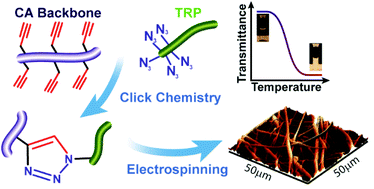Temperature-responsive fibres of cellulose-based copolymers†
Abstract
Well-defined temperature-responsive cellulose acetate (CA) grafted with a temperature-responsive polymer (TRP) was synthesized using a grafting-to approach. The TRP obtained by reversible addition–fragmentation chain transfer polymerization (RAFT), with Mn = 17 700 and dispersity Đ = 1.10, is a random copolymer of di(ethylene glycol) methyl ether methacrylate (MEO2MA) and oligo(ethylene glycol) methyl ether methacrylate (OEGMA), containing terminal azide groups introduced by addition of an azide-modified methacrylate monomer in the final stage of the polymerization. For the comonomer ratio used, the volume phase transition temperature of the TRP is TVPT = 33 °C. After modification of CA with propargyl groups using the remaining hydroxyl groups of the glucopyranose rings, the TRP was grafted to the CA by an azide-propargyl click reaction. The CA-g-TRP copolymer was then used to prepare fibers by electrospinning, for application as temperature-responsive scaffolds in cell culture. The fibers were found to change their average diameter from 2.0 ± 0.4 μm to 1.3 ± 0.3 μm upon heating in water, above the TVPT, and subsequently drying. When cooled in water below the TVPT, the average diameter increases to 1.8 ± 0.3 μm. Experiments in thin films of the same copolymer show that the change in temperature does not translate into a significative change in the hydrophobic character, possibly due to a conformation rearrangement of the copolymer chains.



 Please wait while we load your content...
Please wait while we load your content...